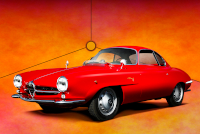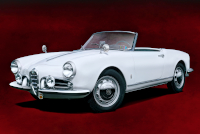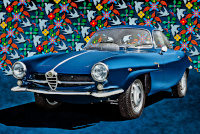Location:
Radnor Hunt Concours d'Elegance, 2015
St. Michaels Concours d'Elegance, 2012
Radnor Hunt Concours d'Elegance, 2007
Owner: Wicker Francis | Newtown Square, Pennsylvania
Prologue:
Perhaps one of the most difficult shapes to capture in a pleasant perspective, Franco Scaglione's design is rather brilliant. The Sprint Speciale is not easy on the eyes, and yet at a certain angle it is perfect. So, while I feel compelled to defend the design, I will also agree one simply can't expect any snapshot of the car to turn out well.
The Sprint Speciale is also a tricky car to contextualize; it would seem at home next to a Karmann Ghia, a bizarrely cute German cousin, just as much as the Alfisti elevate its stature to that of a baby GT berlinetta. But whether one exhalts the Sprint Speciale because of its lineage or takes a rather more pragmatic view on account of its eccentricity has become more of a market-influenced question. The glamour of owning a vintage Alfa far exceeds that of a vintage Volkswagen. Driving impression surely matters, but then again the Sprint Speciale also fell short of the competitive purpose it was meant to serve.
In any case, what we present here is a have-some-fun approach floated by the promise of more in-depth material to follow. When I first published this profile, I noted that we lacked visuals of the design's intricate tail features, and that I considered working through an uncatalogued navy 1962 model to fill that gap. We've since captured a few more beautiful and intriguing examples with better equipment. So the Sprint Speciale contingent has grown, and may yet continue depending on the extent to which we focus on this design within the broader Alfa Romeo portfolio.
- - - - - - - - - -
► Image Source: Nikon D200 (10.2 MP) | Image Source 7, 8, 9, and 10 by E, used as the basis for illustrations by the author
References:
- Czap, Nick. "Museo Storico Alfa Romeo: The Catalogue" Giorgio Nada Editore, Milano, Italia. 2015, page 132-133
- UltimateCarPage: Our favorite source provides a nice article on the 1957 Giulietta Sprint Speciale Prototipo, by Wouter Melissen, November 7, 2016.
An interesting departure from the formal simplicity that typified the Giulietta, Alfa Romeo conceived the Giulietta Sprint Speciale as a race-worthy successor to the Giulietta Sprint. Handing the design brief to Bertone, designer Franco Scaglione penned a fantastical shape in the name of aerodynamic efficiency. Combining their experience in aeronautics and runway fashion, (the other runway involving ladies), Scaglione and Bertone created the Berlinetta Aerodinamica Tecnica series, known most appropriately as the BATs. The BATs served as a master thesis for a number of prototype and production cars that became more than flights of fancy, but genuine advances in wind-slicing technology.
Depending on the source, the Giulietta Sprint Speciale produces a coefficient of drag in the neighborhood of .28, which it should be said might pertain to the extra-low Sprint Speciale Prototipo, apart from the production series. But whatever the case, in 1957, time of the protype's delivery, no car had ever achieved such a low drag figure, nor would it for decades to come. For context, a modern Ferrari 458 cuts the wind at .33. But modern aerodynamics being more complex, one shape is not better than the other based solely on drag, because of course a modern sports car produces a tremendous amount of downforce at the same time. And that balance of downforce and grip and aerodynamic efficiency is what makes a good performance car.
At the end of the day, the Giuletta Sprint Speciale could clock well over 110 miles per hour with a motor of less than 1.3 litre, but at the expense of handling. Long front and rear overhangs compromise stability, and the broad curves, sloping tail, and large glasshouse contribute to a rather weighty design. While the design brief asked for a race car, the Sprint Speciale instead became a touring car darling, and not an unpopular one.
Production began in 1959. In 1963, the Giulietta Sprint Speciale became the Giulia Sprint Speciale, and production continued until 1966. As for the race track, privateer racers would not be spoiled for choice, opting for the simpler Sprint and uprated Sprint Veloce, or the even lighter Sprint Zagato (SZ).
Motor: 1,290 cc straight 4-cylinder, alloy block, alloy hemi-head | 74 mm x 75 mm | 9.7:1 compression
Valvetrain: DOHC, chain-driven, 2 valves per cylinder
Aspiration: twin Weber 40 DCOE/3 carburetors
Power: 97 bhp at 6,500 rpm
Drivetrain: 5-speed gearbox, rear-wheel drive
Front Suspension: independent via wishbones, coil springs, hydraulic dampers, anti-roll bar
Rear Suspension: live axle located by trailing arms and a triangulated central link, hydraulic dampers
Architecture: pressed steel unitary construction
Kerb Weight: 950 kg (2,094 lbs)
Wheelbase: 2,250 mm (88.58 in)
Top Speed: 183 km/h (113.7 mph)
Etymology:
The Giulietta Sprint Speciale came to market following the lightweight Giulietta Sprint and its up-rated Sprint Veloce cousin. Bertone crafted the prototipo in 1957 using a steel shell with aluminum bonnet, doors, and decklid. The production car is steel. We include the chassis number, the first part of which, '10120,' indicates the factory's Tipo 101.20 designation, identifying the car's place in Tipo 750/101 production.
Figures:
According to the factory catalogue, Alfa Romeo produced 1,252 Giulietta Sprint Speciale cars from 1959 to 1962. The following year, the Giulietta Sprint Speciale became the Giulia Sprint Speciale, and production continued until 1966.
Alfa Origins: Design Precedent in the Alfa Romeo C52 Disco Volante
To understand the Sprint Speciale shape, we must look back at Giaocchino Colombo's C52 Disco Volante design of 1952—actually a pair of concepts—to understand how Scaglione might have been pushed toward low-drag influences. The general outline, an oblique spheroid, as well as the deep tumblehome cabin lines, wrap the Giulietta platform in a similar profile. However, Franco Scaglione chose undulating lines, sensual in comparison, making the Sprint Speciale a true post-modern design, an artefact that fits with the on-rush of the 1960s, as opposed to a theoretical exercise.
BAT Cars: Franco Scaglione Adapts His BAT Exercises for Alfa Romeo Production
From 1953 to 1955, Scaglione and Bertone developed the Berlinetta Aerodinamica Tecnica concepts (BAT 5, BAT 7, and BAT 9). These three bewinged, streamlined escapades provided the basis for translating nascent aerodynamic principles into purpose. The last of the BATs, BAT 9, offers the clearest translation of concept-to-production design elements. The low, sharknose grille composition carries over, as does a less-pronounced crease along the center of the bonnet, evident in the Giulietta's crest and chrome. The Sprint Speciale's cabin shape is highly similar, with a steep-raked wrap-around windscreen and soft, tapering rear quarter windows in keeping with the slant-back roof. Scaglione also retained the tumblehome, raking the sides of the cabin inward as the lines move toward the tail.
German Influence: The Kamm Tail on an Italian GT
A nod toward a no-compromise, maximum benefit approach, Scaglione incorporated a couple simple elements generally attributed to German automotive design. First is the eyebrow over the front wheel arch, as seen on Mercedes-Benz racing cars as early as 1954 with the W196R Stromlienenwagen. Second is the Kamm principle, or the Kammback tail, named for German engineer, Wunibald Kamm. With roots in the 1930s, the near-vertical truncation would define 1960s sports cars, offering simple counterpoint to the sensual curves that made sports cars of that decade so evocative.
The brow integrates with the nose, wrapping beneath the edge of the guard, while also repeating the guard's wind-swept shape. The blade point aims at the low terminus of the tail. As if on the C52 the crease would extend along the flank, here, the brow identifies the body's circumference, the outermost line from which the tumblehome emerges. Completing this shape with a simple Kamm tail minimizes turbulence, both aerodynamically and visually. Somewhat prescient, the Kamm tail will later appear on the Coda Tronca evolution of Zagato's Giulietta SZ, followed by TZ and TZ2 competition berlinettas, placing Scaglione at the forefront of a major trend of 1960s racing design.
Red Rubber Duck: A Dose of Awkward Marvelous
Comparison to the BATs is perhaps unfair, because the BAT cars are outrageous from every angle. The Sprint Speciale is beautiful from certain angles, but occasionally reverts to red rubber duck proportions. This red rubber ducky owes its awkwardness to long front and rear overhangs and a lengthy cabin with truly large glass surfaces all round, creating a profile almost out of the Bauhaus school. (Think of a classic Italian Audi TT.) So the Sprint Speciale needs a slight overhead perspective to be understood; it needs to be seen in the round, otherwise the profile flattens the cabin curves and gently undulating shoulders into a confusing, off-kilter mix of lines that do not express the sculpture in all its dimensions. If viewed from above, however, the car's slipstream design expresses its aerodynamic efficiency, which history tells us is a beautiful, landmark achievement.
Last Updated: Mar 26, 2025












